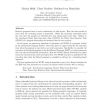Free Online Productivity Tools
i2Speak
i2Symbol
i2OCR
iTex2Img
iWeb2Print
iWeb2Shot
i2Type
iPdf2Split
iPdf2Merge
i2Bopomofo
i2Arabic
i2Style
i2Image
i2PDF
iLatex2Rtf
Sci2ools
ENTCS
2008
2008
Worst Case Reaction Time Analysis of Concurrent Reactive Programs
Reactive programs have to react continuously to their inputs. Here the time needed to react with the according output is important. While the synchrony hypothesis takes the view that the program is infinitely fast, real computations take time. Similar to the traditional Worst Case Execution Time (WCET), the Worst Case Reaction Time (WCRT) of a program determines the maximal time for one reaction. In this paper, we present an algorithm to determine the WCRT of a program written in the synchronous language Esterel. This value gives an upper bound for the execution time when the program is executed on a reactive processor. Specifically, we consider the execution of the Esterel program on the Kiel Esterel Processor (KEP), a reactive processor that can execute Esterel-like instructions. Here the WCRT directly determines an upper bound on the instruction cycles per logical tick. The WCRT also gives a guideline for the execution time when the Esterel program is compiled to software by a simu...
| Added | 10 Dec 2010 |
| Updated | 10 Dec 2010 |
| Type | Journal |
| Year | 2008 |
| Where | ENTCS |
| Authors | Marian Boldt, Claus Traulsen, Reinhard von Hanxleden |
Comments (0)

